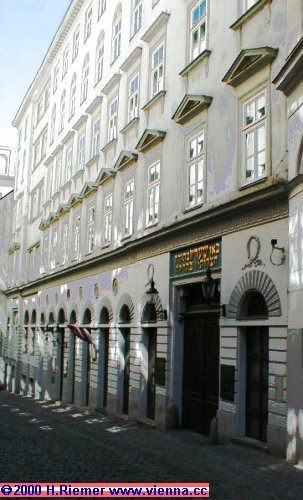
This synagogue survived World War II because it was owned by a non-Jew, and it's apartment building apperance hides the magnificant praying space inside. (Click on the title of this blog: ''A Powerful Prayzer...'' to view the inside of this synagogue).
After praying, we had dinner at the kosher resturaunt just next door to the Synagogue. As we were walking out of the resturant, Aunt Cheryl remembered that we had not said Birkat Hamazon (after meal ''thank-you'' prayer). We stopped, and sat down on a step just between the resturaunt and the synagogue to recite the blessings as locals and tourists walked by to the neighborhood pub.
What an incredible privilage and sensation that was! To be reciting a Jewish prayer on an Austrian street in public. When just 60 years prior, we would have been imprisoned, shot, or sent to a concentration\death camp for doing such a thing. What an incredible place to be demonstrating our appreciation for our food, good fortune, and happiness to be alive.
HISTORY
www.jewishvirtuallibrary.org
In March 1938, Austria was annexed by Nazi Germany, the Anschluss. Following the annexation, Jews were chased through the streets, were forced to scrub the sidewalks and Jewish stores and apartments were pillaged. The Social Democratic party was crushed and thousands of Austrians who opposed Nazi rule were deported to concentration camps and murdered.
The Nazis enacted the Nuremberg Racial Laws in occupied Austria in May 1938. Within a short period, Jews had lost nearly all of their civil liberties, they were unable to attend university, were excluded from most professions and were forced to wear a yellow badge. All Jewish organizations and institutions were shut down. The Nazis encouraged emigration and nearly 130,000 Jews left Austria, including 30,000 who went to the United States.
Many Jewish stores, factories and building were destroyed during Kristallnacht on November 9-10, 1938. Public displays of hatred commenced across the city and all of the city’s synagogues were ravaged. The only synagogue that remained untouched was the central synagogue, hidden because of residential surroundings. That night about 6,000 Jews were apprehended and sent to Dachau.
The situation further deteriorated after the Wanassee Conference in January 1942. The remaining Austrian Jews were killed or sent to concentration camps; more than 65,000 Viennese Jews were deported to concentration camps, only 2,000 survived. About 800 Jews who managed to hide survived the war.
Today, Vienna has 15 synagogues, but the only surviving synagogue from the pre-war era is the Vienna Synagogue (Stadtempel), which houses the community offices and chief rabbinate. The synagogue was damaged during the war and reopened in 1963 after extensive renovations. The synagogue has limited visiting hours and heavy security (due to a 1982 terrorist attack). The spectacular round sanctuary has the look and feel of a Reform temple, but it is an Orthodox congregation with a separate gallery for women. Long discussions were held over whether to permit an organ and adopt more elements of Reform Judaism, but, ultimately, the decision was to stick with orthodoxy but to have some modern touches; for example, the bimah was placed in front of the ark instead of the middle of the sanctuary.
Besides for the Stadtemple, there are a number of prayer rooms serving various Hassidic sects and other congregations. Efforts made by the Lubavitch movement have increased synagogue attendance, especially of Georgian and Bokharan Jews, who have since opened their own synagogue. In 1984, the Zwi-Peretz Chajes-shule was reopened and, in 1986, the Lauder Foundation established the Beth Chabad Shules and other educational institutions. While only ten percent of the Jewish community is actively Orthodox, there are no Conservative, Reform or Reconstructionist synagogues.
No comments:
Post a Comment